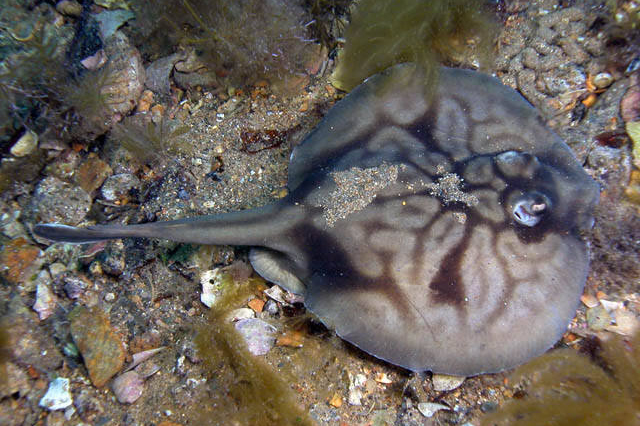Coastal Stingaree, Urolophus orarius Last & Gomon 1987

A Coastal Stingaree, Urolophus orarius, at Rapid Bay Jetty, South Australia. Source: Dave Harasti / www.daveharasti.com. License: All rights reserved
Summary:
An almost circular greyish to brown stingaree, with dark blotches across the eyes, body and base of the tail, and a pale whitish-grey underside. The Coastal Stingaree has an almost circular disc with a stout tail measuring about three-quarters the length of the body disc, a spear-shaped caudal fin with a prominent, serrated, venomous spine, and no dorsal fin.
Cite this page as:
Bray, D.J. 2018, Urolophus orarius in Fishes of Australia, accessed 02 Apr 2025, https://fishesofaustralia.net.au/Home/species/3541
Coastal Stingaree, Urolophus orarius Last & Gomon 1987
More Info
|
Distribution |
Endemic to South Australia in the eastern Great Australian Bight from Beachport to off Fowlers Bay, including in the southern parts of both Spencer Gulf and the Gulf St Vincent. Inhabits inshore sandy and shelly areas. |
|
Feeding |
Feeds mostly on crustaceans. |
|
Fisheries |
Taken as bycatch in the commercial trawl fisheries. |
|
Similar Species |
Differs in colour pattern from both the Banded Stingaree, Urolophus cruciatus, and the Yellowback Stingaree, Urolophus sufflavus. The Coastal Stingaree lacks the dark median stripe of the Banded Stingaree, and has dark blotches near the pelvic fins that are absent in the Yellowback Stingaree. The Coastal Stingaree also has a relatively longer tail and caudal fin than the other two species. |
|
Species Citation |
Urolophus orarius Last & Gomon 1987, Mem. Mus. Vict. 48(1): 65, fig. 3. Type locality: Investigator Strait, South Australia [35°20´S, 137°50´E]. |
|
Author |
Bray, D.J. 2018 |
|
Resources |
Coastal Stingaree, Urolophus orarius Last & Gomon 1987
References
- Gomon, M.F., Yearsley, G.K. & Last, P.R. 2008. Family Urolophidae. 125-137 pp. in Gomon, M.F., Bray, D.J. & Kuiter, R.H. (eds). Fishes of Australia's Southern Coast. Sydney : Reed New Holland 928 pp.
- Last, P.R & Gomon, M.F. 1987. New Australian fishes. Part 15. New species of Trygonoptera and Urolophus(Urolophidae). Memoirs of Museum Victoria 48(1): 63-72 https://doi.org/10.24199/j.mmv.1987.48.15Open access
- Last, P.R. & Gomon, M.F. 1994. Family Urolophidae. pp. 172-181 figs 150-159 in Gomon, M.F., Glover, C.J.M. & Kuiter, R.H. (eds). The Fishes of Australia's South Coast. Adelaide : State Printer 992 pp. 810 figs.
- Last, P.R., Kyne, P.M. & Marshall, L.J. 2006. Urolophus orarius. The IUCN Red List of Threatened Species 2006: e.T60100A12299964. http://dx.doi.org/10.2305/IUCN.UK.2006.RLTS.T60100A12299964.en. Downloaded on 16 June 2018.
- Last, P.R. & Stevens, J.D. 1994. Sharks and Rays of Australia. Canberra : CSIRO Australia 513 pp. 84 pls.
- Last, P.R. & Stevens, J.D. 2009. Sharks and Rays of Australia. Collingwood : CSIRO Publishing Australia 2, 550 pp.
- Last, P.R., Yearsley, G.K. & White, W.T. 2016. Family Urolophidae pp. 676-705. In: Last, P.R., White, W.T., de Carvalho, M.R., Séret, B., Stehmann, M.F.W. & & Naylor, G.J.P. (eds) Rays of the World. Melbourne: CSIRO Publishing, 800 pp.
- Walker, T.I. 2004. Catch susceptibility of chondrichthyan animals to demersal fishing gear in the South East Scalefish and Shark Fishery. PIRVIC: Queenscliff.





